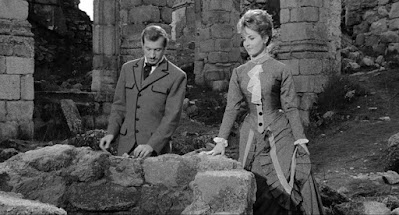The Blancheville Monster is a 1963 Spanish-Italian gothic horror movie made mostly in Italy but with some location shooting in Spain. It was one of the first films directed by the young Alberto De Martino and was his first foray into horror. He was rather dismissive of this early effort but it’s actually very enjoyable.
It was also released under the title Horror with Edgar Allan Poe’s name prominent on the posters. In the 60s lots of movies made use of Poe’s name despite having no connection to any of his works. In this case however this really is a very Poe-like movie. It’s not an adaptation of a particular Poe story but the Poe flavour of aristocratic decay and decadence and doom and old families descending into madness is very very strong. It uses elements from The Fall of the House of Usher and from another Poe story which I won’t name since that would reveal a spoiler.
This movie was also clearly influenced by the success of Roger Corman’s Poe films, especially his 1960 The House of Usher. The Blancheville Monster is therefore Poe with a Corman flavouring and with an Italian sensibility.
The names of the characters can be confusing since there are huge differences between the Italian-language version and the English-dubbed version. The English version indicates the setting as Brittany but the Italian version makes it clear that this is Scotland in 1884. The decaying aristocratic Blackford family in the Italian version becomes the de Blancheville family in the English version.
It’s obvious from the start that De Martino is going to throw at us every gothic trapping and cliché he can get his hands on. That’s part of the reason this movie works. If you’re going down the gothic road you might as well go all the way. Gothic horror cannot be too excessive.
We start in the forest and then we get a glimpse of a decaying gothic castle. The film was clearly shot in autumn. There’s not a single leaf on any of the trees. There’s a feeling of desolation and death.
A carriage arrives at the castle. Emily Blackford (Ombretta Colli) is fresh from school and is to be reunited with her brother Roderick (Gérard Tichy). She is accompanied by her friend Alice Taylor (Irán Eory) and Alice’s brother John (Vanni Materassi).
It’s not entirely a joyful homecoming since old Lord Blackford (the father of Emily and Roderick) was burnt to death in an accident a year earlier.
Emily discovers that old of the old familiar servants are gone, and when she asks what happened to them she gets evasive answers. This immediately offers a hint that something is not quite right at Blackford Castle.
And then Emily is introduced to the new housekeeper, Eleonore (Helga Liné). Eleonore is much too beautiful and much too glamorous and the two women distrust each other on sight. Eleonore is dressed in black and looks like a young sexy version of Mrs Danvers. We know there has to be something sinister about her.
De Martino immediately has the viewer feeling uneasy about all of the inhabitants of this crumbing castle. Roderick has taken to brooding. Eleonore is obviously sinister. The family doctor, Doctor Atwell (Leo Anchóriz), is shifty. The new butler, Alastair, is evasive.
And De Martino keeps us guessing about these people. Is Roderick haunted by the past, is he crazy, is he evil or is he just gloomy and moody? Is Emily going crazy? Is it some hereditary madness, is her mind being poisoned, is she being actually poisoned or deliberately driven insane or is she just unable to cope with the atmosphere of gloom in this castle? Is the doctor involved in some mysterious plot? Is Eleonore involved in a sinister conspiracy? De Martino offers us some hints and some red herrings as well.
The screenplay by Giovanni Grimaldi and Bruno Corbucci takes Poe’s The Fall of the House of Usher as a jumping-off point but it’s not even vaguely a faithful adaptation. It’s more of a Poe-esque gothic horror mystery romance.
The Spanish locations (in a spectacular ruined abbey) are used with considerable skill. The location shooting, the matte paintings and the miniatures effects do not combine to achieve anything approaching realism, but this is gothic horror. It’s not supposed to feel realistic. This is the gothic world, a world where dream and reality intersect, where the past and present co-exist, and it’s a world of unconscious fears, drives and longings. This movie has exactly the right gothic feel. And it does look great. The black-and-white cinematography is very impressive.
There’s a rather nicely done dream sequence.
It was a very strict rule at the time that a gothic horror movie had to include a scene with the pretty heroine wandering down a mysterious sinister castle corridor in a filmy nightdress and carrying a candelabra. And preferably descending or ascending a spooky stairway. Since this movie includes every known gothic trope it naturally has such a scene.
De Martino may have been inexperienced but he was already very competent.
The Blancheville Monster may not be groundbreaking and it may not be top-tier gothic horror but it has all the right ingredients nicely combined and the result is fine entertainment. Highly recommended.
This is part of Arrow’s Gothic Fantastico Blu-Ray boxed set which also includes Lady Morgan’s Vengeance (1965), The Third Eye (1966) and the excellent The Witch (La strega in amore, 1966). The Blancheville Monster gets a lovely transfer and there’s an audio commentary.





No comments:
Post a Comment